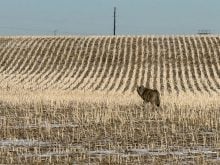The federal government plans to extend Employment Insurance benefits to self-employed Canadians, including farmers, but farm leaders are split on how much benefit the move will bring.
Details of how it would work, how much it would cost farmers and what benefits they might draw remain unclear, which led to the farm leader skepticism.
“Overall, it sounds like good news,” Canadian Federation of Agriculture president Laurent Pellerin said after the Nov. 3 announcement by human resources minister Diane Finley.
“But it is very unclear how it will work. What will the details be? How much will premiums be and when is a farmer no longer self-employed? They could be paying premiums until they die.”
Read Also

Agritechnica Day 2: The future of tractor power, building quicker crop apps and large farms and tech
Agritechnica Day 2: The future of tractor power, building quicker crop apps with Syngenta and large farms and tech
Rick Phillips, executive director of Grain Growers of Canada, was in Toronto for the announcement and was enthusiastic.
“This could be the difference as to whether one member of the family has to seek off-farm employment because now families will have a choice,” he said in a statement embracing the announcement.
“With over 200,000 farms in Canada, if even 10 percent of them choose to take advantage of these programs, this could help ensure another 20,000 more young families staying on the land.”
Ontario Federation of Agriculture vice-president Mark Wales wasn’t so sure.
“Until we see the details, there is not a lot to get excited about here,” he said.
“Some of the questions we have suggest it might not be such a good deal for most farmers.”
Finley said self-employed Canadians could decide to join the EI program any time after Jan. 1, 2010, would have to begin paying premiums during that tax year and would be eligible to apply for benefits a year after opting in, as early as Jan. 1, 2011.
It is expected premiums would be the same as for salaried workers covered by the program – $1.73 for each $100 of insurable earnings to a fixed maximum. To be eligible to apply for benefits, the farm would have to have produced at least $6,000 in earnings the previous year.
It would not be an income replacement program during months when most farm work has stopped.
Instead, the program would pay what are considered “special benefits,” including payments during maternity leave up to 15 weeks, up to 35 weeks of benefits for parental leave after birth or adopting, up to 15 weeks of sickness benefits and up to six weeks of benefits to allow for someone to care for a family member with a serious illness.
Once benefits are claimed in one year, the farmer would be locked into the system and its annual premiums until they are no longer “self-employed.”
Wales said farmers will have to seriously consider what the possible benefits of the program would be compared to perhaps a lifetime of annual contributions.
He said the government will have to clarify whether contributions are on gross or net income.
“And when does a farmer really retire? Some work until they die,” he said. “While this could benefit some farmers in some situations, I’m not sure I see it is a great program for farmers.”
The OFA has called for years for farmers to be eligible for the EI program.
Phillips said EI money could be used to hire an extra employee when one of the farm partners is caring for a new baby, is ill or caring for a sick relative.














